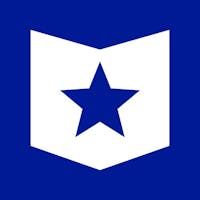It was an unanticipated scheduling issue that challenged Dr. Bruce Robertson to completely redesign a classroom course to fit an online/in-class hybrid format—in just two weeks.
Right before the start of the Fall semester in 2002, Robertson learned that the 400-seat movie theater that held his Principles of Marketing class at San Francisco State University would no longer be available. In its stead, he was offered a 150-seat classroom on campus. The only way to overcome the seating limitation was to turn to technology. As it happens, that was one of the best things that ever happened to him. In fact, it is the reason his sought-after courses now are able to accommodate up to 1,400 people per semester—offering each student a learning experience that is more flexible, personalized, and engaging than ever before.
Recently, Robertson became a member of the Course Hero Faculty Club, a platform where professionals in higher education share their teaching innovations, inspiration, and practical advice with the goal of helping all students learn deeply and graduate confident and prepared. He spoke with Course Hero about how he transformed his classes using a modular approach—and the unexpected benefits he has seen since.
Join the Club: Educators interested in learning more about Faculty Club opportunities, or being featured in an interview, are invited to reach out to us at educators@coursehero.com.
Using tech to personalize learning
Robertson has long believed that the linear approach to teaching may not be right for everyone. Different students have different approaches to learning, he says. “But they’re all expected to run through the same program, and the program is linear—which means we do chapter 1, then we do chapter 2, then we do chapter 3.” This, he says, leaves some students bored for the first few weeks, while others struggle through the introductory material.
When forced to redesign his course, Robertson saw an opportunity to move toward a curriculum that offered more flexibility than his linear syllabus ever could. His choice: modular learning. In this system, students choose from a menu of content delivery options (textbook, downloadable study guides, lectures) and interaction options (in-person or online). Students can complete modules at their own pace and in any order, creating an individualized experience. Today’s technologies, he notes, make it easier than ever to create, distribute, and navigate such a curriculum.
“What we’re doing is redesigning courses that are appropriate to the technology that’s available today,” says Robertson. “If I have the technology infrastructure set up, there’s no reason for two students to have to have the same experience in an online classroom.”
Creating modules, one step at a time
In 2002, Robertson began to “chunk” his long lectures into short videos, each focusing on a specific topic. Over the next few years, he also interviewed dozens of experts in the subject and applied for a technology grant, which he used to redesign his website to support modular learning. In 2013, he documented the experience in a case study in the Atlantic Marketing Journal, titled “Operating a Very Large-Section, Hybrid Principles of Marketing Class at a Public University: Lessons Learned over Ten Years.”
Today, Robertson’s course consists of 150 to 200 online modules, each of which includes a video presentation, a section from his own book Marketing Fundamentals for Future Professionals, and—coming soon—an active learning exercise. (See sidebar, “Robertson’s Content Options for Hybrid Courses.”)
Adapting to a modular curriculum
Robertson notes that redesigning a curriculum using modules allows educators to build a cache of materials a little at a time. Also, since one module can be added or revised without affecting the others, it is easy to redesign course content piecemeal, as the need arises.
Here are the steps he recommends for getting started:
1. Seek out tech support
Creating engaging online education materials requires teamwork, collaboration, and creativity, Robertson says. “This isn’t something that you meander into.” To this end, he has built partnerships with graphic designers, programmers, and videographers. It is vital, he says, to find people who understand the technology and visual presentation. “I’ve been trained in the blackboard- and text-oriented world,” he says. “But nowadays, [student learning] is very graphic and video-oriented—which is a different skill set.”
2. Edit, then edit some more
Robertson created his first modules by breaking his 75-minute lectures into YouTube videos of about 15 minutes each. However, he soon realized these videos were still too long. “I took an online [business] class,” he says, “and it was torture.” He decided that it was unrealistic to ask his students to watch more than 10 minutes at a time. “I’d like to get it down to two to three minutes per video.”
3. Provide recommended paths
While the goal for modules is that they be mixed and matched, it is extremely beneficial to provide at least three or four suggested paths, says Robertson. For example, one path might be for non-business majors and another would cater to working marketing professionals. “I would also recommend being able to sort them into beginner and advanced modules,” he says.
4. Offer experiential exercises
Robertson is still planning these exercises; his goal is to let students learn by doing rather than just by consuming. He explains that an experiential exercise can be as simple as a video game, such as the simulation Lemonade Stand. Here, the player is given money, a weather report and lemonade supplies. At the end of the day, students assess how they did and adjust accordingly. He intends to use this module to have students practice “product price promotion and distribution,” with the goal of earning $100.
5. Use technology to make it all manageable
Technology makes it easy to send out reminders, administer quizzes and offer immediate feedback. “There are so many great things you can do in the online world that are not possible at all in the offline world,” he says.
Robertson is also a huge proponent of learning management software. Some systems allow the user to hyperlink a table of contents to an ebook, YouTube video and other supplementary content. This allows for easy navigation and access by students.
6. Experiment with gamification
Robertson is now exploring the use of gamification—creating a set of modules that students will complete to unlock the next level of modules—as is common in video games. This approach combines a sense of control with a feeling of accomplishment, both of which Robertson says drive engagement. “Research has shown that if people feel like they’re in control of whatever they are doing, they will be more satisfied with whatever they are doing.”
Results that speak for themselves
With the module system, 22% more of Robertson’s students are passing his course than ever before. The class also has a good reputation among students, attracting 300 non–business majors each semester. “That’s saying something,” he says.
What also says something: the long-term impact. Many former students have expressed an interest in having access to the modules after graduation. “Ideally, we would make modules available outside class for alumni so when they graduate, they don’t lose access to the materials,” he says.
Consider that version 2.0. And you can bet he is working on it!
Robertson’s Content Options for Hybrid Courses
Dr. Bruce Robertson delivers content in a variety of ways in his hybrid course, noting that some methods work better than others, depending on the student. Here are his options, along with some of their salient characteristics:
Textbooks—These are written specifically for the class to ensure consistency of content across platforms. Robertson offers:
- Traditional bound version, for those who want to keep the book as a resource
- Loose-leaf version, makes it easier to take notes in class, and can replace downloadable study guides
- E-book
Lectures—These illustrate the topics with relevant, timely examples. These are also delivered in various formats:
- In-person lectures allow students to take the class in the traditional manner, and allow real-time Q&As.
- Video stream lectures allow same-day access for online students.
- YouTube channel offers five- to 10-minute clips for each topic, and allows students to access content after graduating.
Tests—Students have unlimited attempts at quizzes, which allow them to make and correct mistakes without sacrificing their grades. Missed questions, he adds, are far more diagnostic than questions answered correctly. He offers the following:
- Live tests offer unlimited attempts for one week; the deadlines encourage students to keep up with class.
- Review tests are ungraded practice versions of the live tests. These allow students to have access to the test banks after the live test has expired.
Activities—These are interactive exercises tied to specific topics. For Robertson, this area is still under development.



